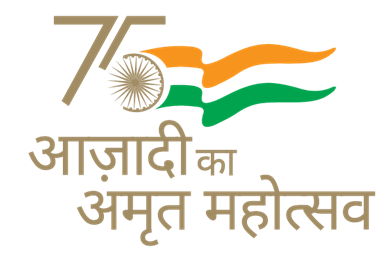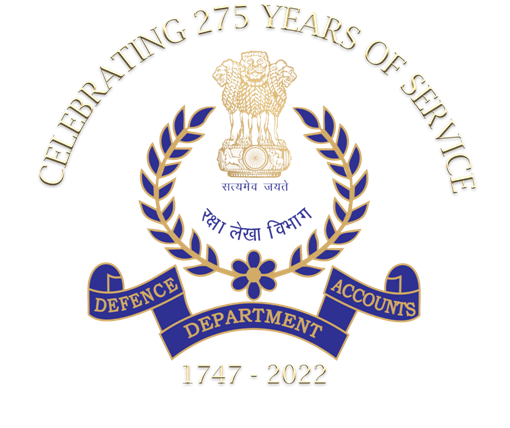भारत सरकार | रक्षा मंत्रालय | GOVERNMENT OF INDIA | MINISTRY OF DEFENCE |
हिन्दी Skip to Main Content |
|---|
 |
 |
 |
 |
 |
 रक्षा लेखा महानियंत्रक कार्यालय की दिनांक 22 सितम्बर, 2025 को आयोजित राजभाषा कार्यान्वयन समिति की तिमाही बैठक का कार्यवृत्त का प्रेषण।
रक्षा लेखा महानियंत्रक कार्यालय की दिनांक 22 सितम्बर, 2025 को आयोजित राजभाषा कार्यान्वयन समिति की तिमाही बैठक का कार्यवृत्त का प्रेषण। Defence Accounts Department Day - 2025
Defence Accounts Department Day - 2025 Assumption of charge to the post of Spl. CGDA -Sh. Vishvajit Sahay, IDAS on 12-09-2025
Assumption of charge to the post of Spl. CGDA -Sh. Vishvajit Sahay, IDAS on 12-09-2025 रक्षा लेखा महानियंत्रक का संदेश
रक्षा लेखा महानियंत्रक का संदेश  Shri Raj Kumar Arora, IDAS has assumed the charge of Controller General of Defence Accounts w.e.f 01.08.2025 (FN).
Shri Raj Kumar Arora, IDAS has assumed the charge of Controller General of Defence Accounts w.e.f 01.08.2025 (FN). Advisory on Phishing Email Incident and Security Measures.
Advisory on Phishing Email Incident and Security Measures. URGENT NOTICE - Beware of Fake Message on Social Media
URGENT NOTICE - Beware of Fake Message on Social Media Conducting of SAS Examination in the Defence Accounts Department: Modification in the SAS Rules 2019.
Conducting of SAS Examination in the Defence Accounts Department: Modification in the SAS Rules 2019.
“Samarth” and “Dolphin”
Pay and allowances of Personnel Below Officer Rank (PBOR) of the Indian Army including JCOs holding Honorary Commissioned Ranks are maintained Corps/Regiment-wise on Individual Running Ledger Account (IRLA) System in 44 Pay and Accounts Offices(PAOs) of Defence Accounts Department spread across the country. These PAOs maintain about 14 lacs accounts of the serving PBOR, in addition to approximately 4 lacs accounts of retired PBOR.
The existing procedure of the maintenance of the Pay Accounts of PBOR on IRLA System started way back in 1946 taking into account unique service conditions of the Army Personnel. The Indian Army is very mobile in nature and its units can be asked to move at a short notice from one place to another. The units can be deployed in different types of locations ranging from peace, modified field or field to regular, high altitude or remote localities. Different types of locations entitle Army Personnel to different type of allowances. The mobility of the units may result in part of month being spent in one type of location and balance in a different type of location. Such unique service conditions rule out the monthly pay bill system as followed in case of civilian government employees. The salient features of the IRLA system and the improvements made therein are explained below.
The individual pay accounts are maintained by PAOs right from enrolment till cessation of service. This ensures that the account remains static in one office despite all the transfers/ movements of the Army personnel. Various changes to his entitlements are notified by Record Office and Unit, where he is serving, by Daily Part II orders which are sent to the PAO for incorporating the financial effect in the accounts. The individual is paid monthly by the Unit and such payments are treated as advances and communicated to the PAO for incorporation in the accounts. Similarly, other recoveries like loans, insurance policies, water/ electricity charges etc. are communicated to the PAO.
Traditionally, the individual accounts (IRLAs) were maintained manually and closed once in a quarter after giving effect to the various changes in entitlements, advances drawn, loans/ recoveries and contributions to provident fund, group insurance etc. After such closing, the Quarterly Statement of Account for every Army Personnel was prepared to indicate his entitlements and other credits, drawls/recoveries and the closing balance. These statements were sent to the Unit of the concerned personnel to apprise him of the status of his account.
In order to improve the quality, efficiency and accuracy of accounts, the pay accounting work in PAOs was computerized in 1980s using COBOL/Unix platform. The processing of inputs was done in batch processing mode and cleaned inputs of the quarter were used for closing and generation of Statements of Accounts.
Despite the major improvements made in the pay accounting system of Army personnel, there were limitations. The processing was in batches and the final acceptance or rejection of the inputs became known only at the time of quarterly closing of accounts and the corrective action could be taken only in the following quarter. Army personnel had to draw their approximate entitlements as advances on pre-determined days and the system did not make use of the current facilities available in the banking sector in the country. The disbursements made to Army personnel were booked to the relevant expenditure heads of Government accounts only after quarterly closing of accounts. Till the closing of accounts, such disbursements continued to remain outstanding under suspense heads.
In the quarterly closing of pay accounts of Army Personnel, the position of non-adjustment or incorrect adjustment of credits/debits could be known at the end of quarter only. Similarly, action to rectify such non-adjustment or incorrect adjustment was possible in the subsequent quarter(s). This delay led to grievances and complaints. The desire to overcome the above and to correct them at the earliest was a major motivating factor.
The aspirations and expectations of the Army personnel to draw their net monthly entitlement through their bank account (instead of cash) and to make use of banking facilities like ATM cards etc. were not adequately met in the system. The vision to meet these expectations was a major motivating factor.
From accounting perspective, the system reflected the booking of expenditure only once in a quarter and substantial amounts continued to be reflected under suspense heads. The desire to correct this position was also a motivating factor. Two projects namely “Samarth” and “Dolphin” have been developed as briefed below:
Project “Samarath”
Project “Samarath” is an effort to re-engineer the system of pay accounting of Army personnel, to ensure that (a) their pay accounts are closed every month and (b) their net monthly entitlements are remitted into their Bank Accounts, making use of the current facilities available in the banking sector.
In any pay accounting system, accurate and timely actioning of inputs which affect the credits or debits is the most important factor. Therefore, the first priority was to shift the capture and actioning of the inputs from a quarterly cycle to a monthly cycle. In order to provide better customer satisfaction, the status of pay account of every Army personnel on monthly basis should be available to all stakeholders.
Date of implementation of the initiative:
After incorporating necessary modifications in the software, the implementation of Project Samarth for Army personnel started in PAO (ORs) GRRC, Lucknow in August, 2009 and PAO (ORs) AMC Lucknow in Dec, 2009. The pilot testing, parallel run, preparation of Standard Operating Procedure (SOP) was initially completed in these two PAOs. Thereafter, Samarth was implemented in the remaining 42 PAOs in a phased manner.
Samarath is a web based Monthly Pay System for JCOs/ORs developed using open source software i.e. Java/PostgreSQL and runs on Linux environment.
Salient features of the system are:
- The system will calculate the Monthly net entitlements and the same will be credited to ORs bank accounts as in case of Army Officers and other civilians. JCOs/ORs and their families can withdraw any amount from these accounts as and when required through ATM unlike earlier system where the payment was made on a fixed date.
- JCOs/ORs can obtain their fund status by visiting the PAO, they need not wait for three months.
- Monthly pay slips of the ORs are being uploaded on Army Intranet by Record Offices to enable the ORs to download the same at their work locations without having to wait for copy by post.
- Payments on account of fund Withdrawals are credited to the bank account of the individual through this system irrespective of his being in that unit or not unlike older system where an OR has to submit a fresh application for fund withdrawal in case of transfer to other unit.
- In Monthly pay systems for JCOs/ORs, the fund balances are printed on monthly pay slip and they can draw advance/withdrawal from their fund accounts as per their requirements.
Project Dolphin
Project ‘Dolphin’ is an effort to shift the existing COBOL based system to more current RDBMS based on-line system. The project has been developed using open source software i.e. Java/PostgreSQL and runs on Linux environment.
This project is under implementation stage in PAOs. PAOs are now able to credit pay and allowances of PBORs on monthly basis. Like PAO (ASC) Bangalore display the statements of accounts of PBORs (both monthly and quarterly) on their respective websites. PBORs and units have login facility to see their statements of accounts, lodge grievance online and view reply online. PAO (ASC) South, Bangalore has already launched its website and started displaying the monthly and quarterly statement of accounts on website. The other PAOs will be gradually shifted from quarterly to monthly payment to PBORs. PAOs will also launch their websites for login based display of accounts of PBORs on their websites.
Date of implementation of the initiative: The development of the project has been successfully completed in July, 2010. Implementation began in two PAOs in parallel mode in August, 2010. Processing of accounts has been completely switched over to ‘Dolphin’ from COBOL system since September, 2010 and it was further rolled out to another 12 PAOs since then.
Salient features of Dolphin are:
- Dolphin is an online system and hence delivers immediate feedback. As soon as a DO II is fed into the system, the calculation is done by the system immediately unlike earlier COBOL based system where the result was known at the time of quarterly closing. Therefore the rejections can be intimated to the units immediately for rectification.
- Validation checks incorporated in the system ensures that only accurate data is being fed into the system.
- In the COBOL based system, the data was accessible only to the EDP staff making it difficult for the PAO staff to settle any grievance/complaint on real time basis. ‘Dolphin ‘has made data available to all the staff of PAO thereby greatly reducing the complaint redressal time.
- Dolphin has facility to import soft copy of DO II data generated by Record Office/Unit resulting in elimination of data entry work.
- The project facilitates to provide monthly entitlement information to the soldiers. This helps them to lodge complaint/grievance if any with the PAO unlike the earlier system where the soldier gets the statement of account only after quarterly closing.
- The system establishes the authority and accountability. The task functions have been defined. The system keeps track of all the actions performed by the task holder/supervisory staff, also recording date & time of the same.
Designed, Developed & Maintained By : Controller General of Defence Accounts, Ulan Batar Road, Palam, Delhi Cantt.-110010
Best View : 1024*768 pixels